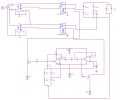Hi Everyone,
I was given this circuit to test as a tap changer for a transformer with an output that has 4 configurations based on how the two SPDT relays are switched. The goal is to bring the voltage down as the output current goes up. I don't understand how the circuit works, its seems as if the npn transistors never come on. When simulating I see a drop in voltage when load goes up but there are spikes on the output voltage.
Please help... thanks


When the load is a short circuit, output is 8V dc

When the load is 1k ohms, output is 30v dc

I was given this circuit to test as a tap changer for a transformer with an output that has 4 configurations based on how the two SPDT relays are switched. The goal is to bring the voltage down as the output current goes up. I don't understand how the circuit works, its seems as if the npn transistors never come on. When simulating I see a drop in voltage when load goes up but there are spikes on the output voltage.
Please help... thanks


When the load is a short circuit, output is 8V dc

When the load is 1k ohms, output is 30v dc







